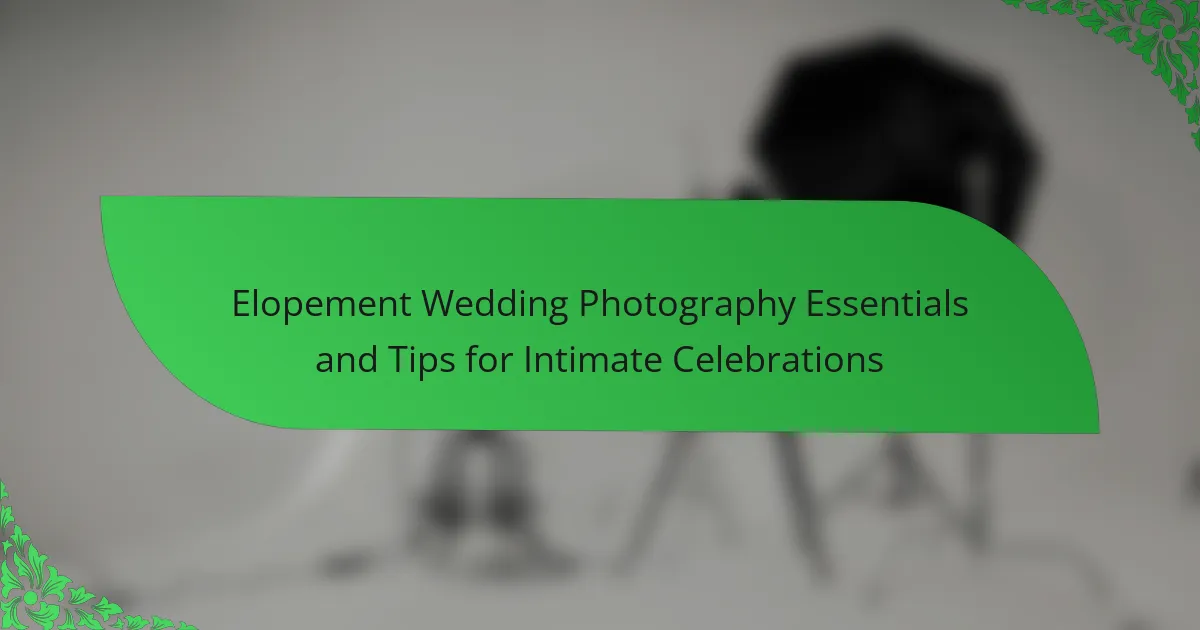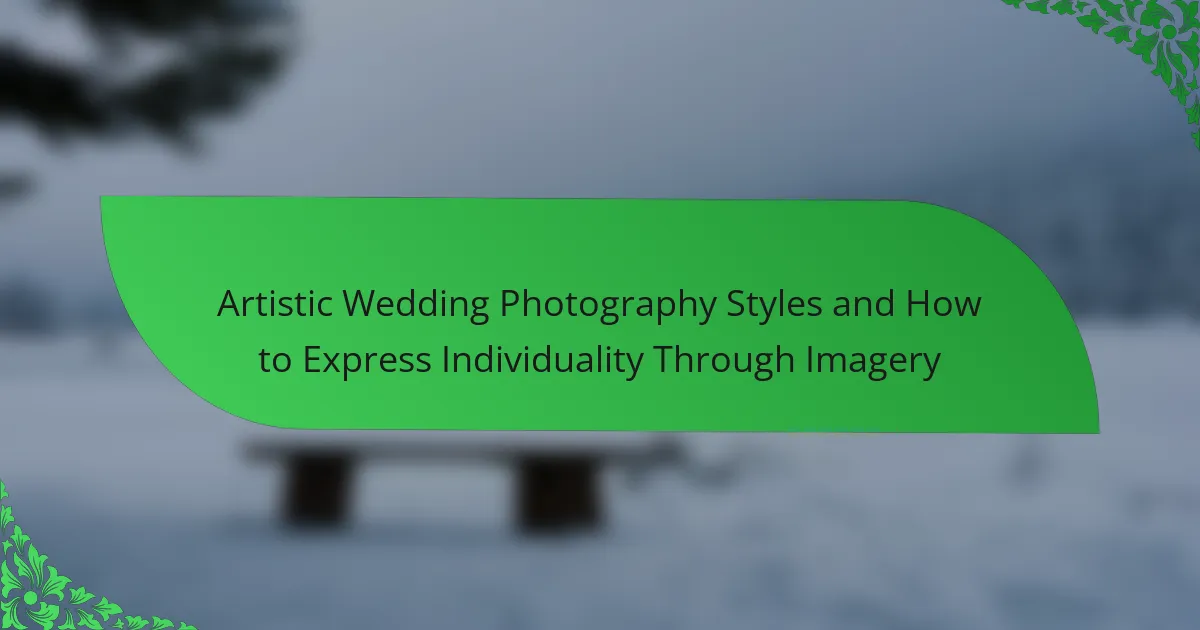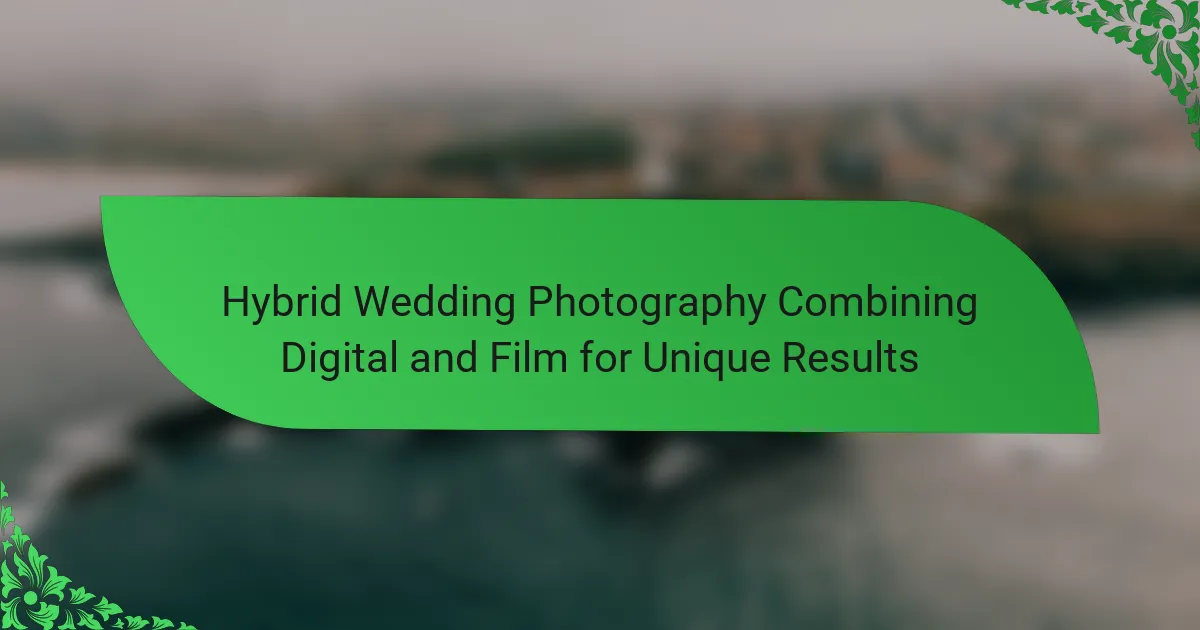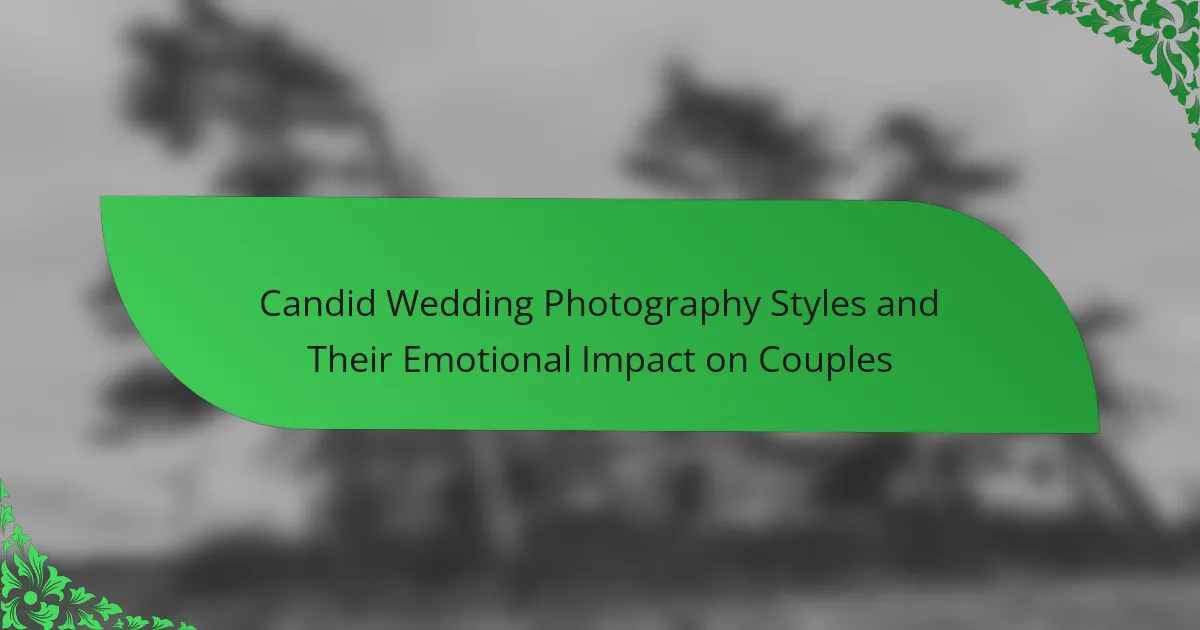Elopement wedding photography focuses on capturing intimate moments between couples in scenic locations while emphasizing personal details. Key aspects include prioritizing candid shots to reflect genuine emotions, effective planning through discussions with the couple, and utilizing natural lighting for enhanced imagery. Couples should select meaningful backdrops, hire experienced photographers, create shot lists, and communicate their vision to ensure a tailored photography experience. Additionally, embracing spontaneity and including personal elements in the shoot contribute to authentic and cherished images. These essential tips collectively guide couples in achieving a successful elopement photography session.
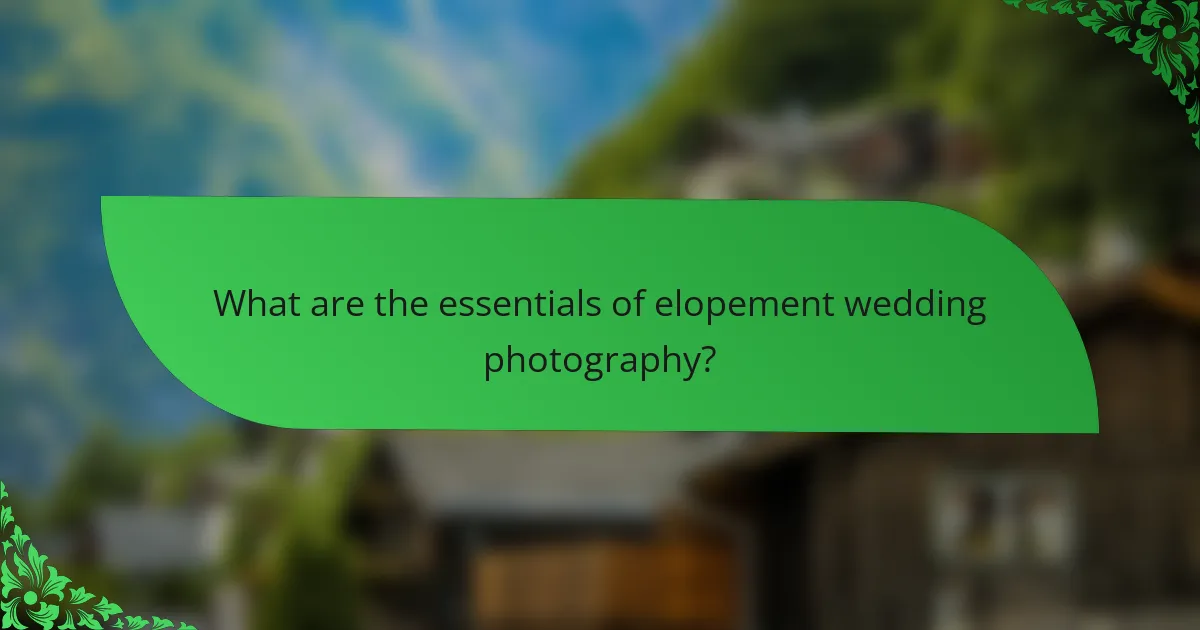
What are the essentials of elopement wedding photography?
The essentials of elopement wedding photography include capturing intimate moments, choosing scenic locations, and focusing on personal details. Photographers should prioritize candid shots to reflect genuine emotions. Planning is crucial; discussing the couple’s vision helps tailor the shoot. Lighting plays a significant role; natural light enhances the imagery. Equipment should be lightweight and versatile for mobility. A backup plan for weather is essential to ensure continuity. Lastly, post-processing should maintain authenticity while enhancing the visual appeal. These elements collectively contribute to a successful elopement photography experience.
How does elopement wedding photography differ from traditional wedding photography?
Elopement wedding photography focuses on intimate, private ceremonies, while traditional wedding photography captures larger, more formal events. Elopements typically involve fewer people, often just the couple and a witness. This leads to a more relaxed atmosphere, allowing for candid moments. Traditional weddings often include extensive planning, larger guest lists, and specific timelines. Elopement photography emphasizes spontaneity and unique locations. Traditional photography usually adheres to classic poses and group shots. The storytelling approach in elopement photography captures the couple’s personal journey, while traditional photography often highlights family and cultural traditions.
What unique challenges does elopement photography present?
Elopement photography presents unique challenges such as limited time for capturing moments. Photographers often have to work quickly to document the ceremony and portraits. The choice of location can also be challenging. Many elopements take place in remote or scenic areas, which may require hiking or navigating difficult terrain. Weather conditions can change rapidly, affecting lighting and visibility. Additionally, the couple may have specific, personal requests that require adaptability. Finally, there may be fewer witnesses, making it essential to capture emotions and interactions effectively. These factors necessitate a high level of planning and flexibility from the photographer.
How can photographers adapt their techniques for intimate celebrations?
Photographers can adapt their techniques for intimate celebrations by focusing on candid moments and emotional connections. They should use natural light to create a warm and inviting atmosphere. Close-up shots of details, such as rings and decorations, enhance the personal feel. Photographers can also utilize a documentary style to capture genuine interactions. A smaller lens can allow for more flexibility in tight spaces. Engaging with the couple to understand their story helps personalize the shoot. This approach fosters trust and comfort, leading to more authentic images. According to a study by the American Society of Photographers, capturing emotions increases viewer engagement by 70%.
What equipment is necessary for capturing elopement weddings?
A camera is essential for capturing elopement weddings. A DSLR or mirrorless camera provides high-quality images. Lenses are important; a versatile zoom lens is ideal for various settings. A prime lens offers excellent sharpness and low-light performance. A tripod stabilizes shots, especially in low light. An external flash can enhance lighting in dim environments. Extra batteries and memory cards ensure uninterrupted shooting. A weatherproof bag protects gear from elements. Lastly, a drone captures unique aerial views of the ceremony. Each piece of equipment contributes to the overall quality of elopement wedding photography.
Which camera settings are ideal for elopement photography?
The ideal camera settings for elopement photography typically include a wide aperture, a fast shutter speed, and an appropriate ISO. A wide aperture, such as f/1.8 to f/2.8, creates a shallow depth of field, which beautifully blurs the background. This helps to emphasize the couple in intimate settings. A fast shutter speed, around 1/200 to 1/500 seconds, captures movement without blur, especially during dynamic moments. The ISO setting should be adjusted based on lighting conditions, typically between 100 to 800 for bright conditions and up to 3200 for low light. These settings ensure sharp images with vibrant colors and good exposure.
What accessories should photographers bring for outdoor elopements?
Photographers should bring essential accessories for outdoor elopements. These include extra batteries to ensure cameras remain operational throughout the event. Memory cards are crucial for storing high-resolution images. A tripod stabilizes the camera for clear shots, especially in low light. Lighting equipment enhances image quality in varying conditions. A lens cleaning kit maintains clear optics against dust and moisture. Reflectors can manipulate natural light for flattering portraits. A portable backdrop provides a controlled setting for couple portraits. Finally, a first aid kit addresses any minor injuries that may occur during the shoot.
What are the benefits of hiring a professional elopement photographer?
Hiring a professional elopement photographer ensures high-quality images that capture the essence of the day. Professionals possess expertise in lighting, composition, and storytelling. They know how to create a comfortable environment for couples, leading to natural and candid moments. Experienced photographers can recommend beautiful locations and optimal times for shooting. They also provide essential post-processing skills to enhance images. Many professionals offer packages that include prints and albums, preserving memories beautifully. Statistics show that couples who hire professionals report higher satisfaction with their wedding photography. Overall, a professional photographer transforms elopement moments into lasting art.
How does a professional photographer enhance the elopement experience?
A professional photographer enhances the elopement experience by capturing intimate moments and emotions. They provide artistic documentation of the day, ensuring memories are preserved. Their expertise allows for creative angles and compositions that elevate the visual storytelling. Professional photographers also understand lighting and settings, optimizing each shot for the best results. They help couples feel at ease, allowing for genuine expressions and interactions. Additionally, photographers can guide couples through poses, enhancing the overall aesthetic. Their experience in elopement photography ensures that unique locations and personal touches are highlighted. This combination of skill and artistry creates a lasting visual narrative of the elopement.
What should couples look for in an elopement photographer?
Couples should look for experience, style, and personality in an elopement photographer. Experience ensures the photographer understands the unique dynamics of elopements. A photographer with a solid portfolio can showcase their ability to capture intimate moments. Couples should assess the photographer’s style to ensure it matches their vision. This includes reviewing their previous work for consistency in aesthetics. Personality is crucial; a photographer should make couples feel comfortable and relaxed. This comfort leads to more genuine and candid photos. Additionally, couples should confirm the photographer’s availability and flexibility for their specific date and location. Clear communication about expectations is also essential for a successful collaboration.
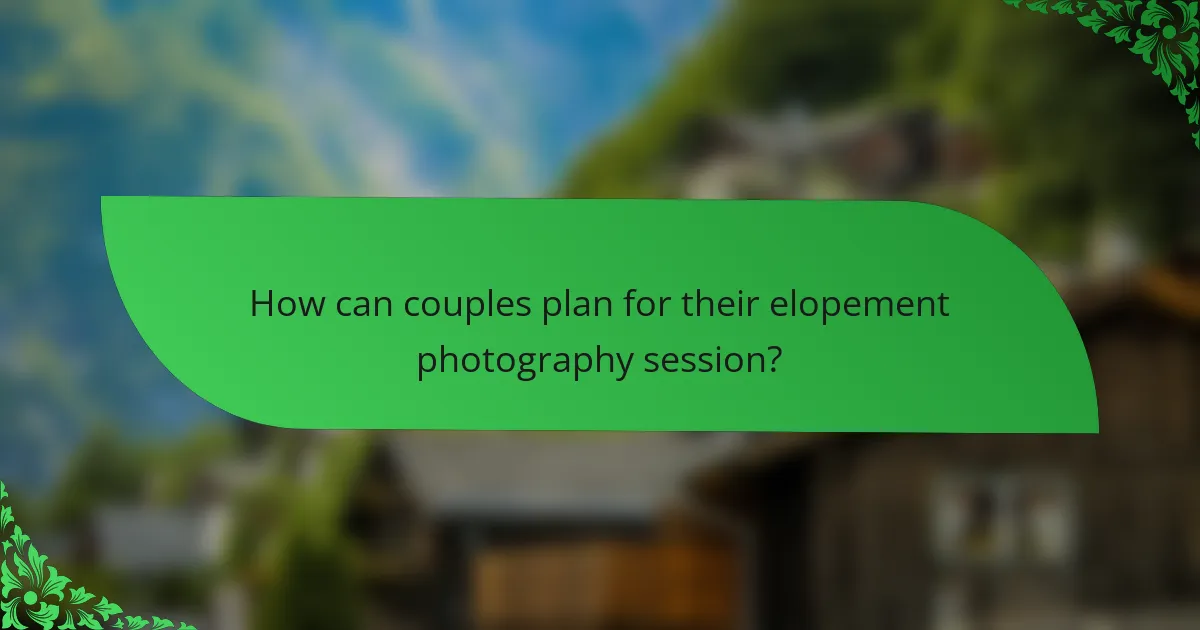
How can couples plan for their elopement photography session?
Couples can plan for their elopement photography session by selecting a meaningful location. Choosing a backdrop that reflects their relationship adds personal significance. Next, they should research and hire a professional photographer experienced in elopement sessions. This ensures they capture the essence of their day effectively.
Couples should also create a shot list of must-have images. This helps the photographer understand their vision. Additionally, they should consider the time of day for optimal lighting. Golden hour, shortly after sunrise or before sunset, provides flattering natural light.
Finally, couples should communicate openly with their photographer about their expectations. This collaboration leads to a more tailored photography experience. Planning these elements ensures a successful elopement photography session.
What locations are best for elopement photography?
The best locations for elopement photography include scenic outdoor settings, urban landmarks, and intimate venues. Popular outdoor locations are national parks, beaches, and mountains. These areas provide stunning natural backdrops. Urban landmarks like iconic buildings and cityscapes offer a modern aesthetic. Intimate venues such as gardens or historic sites create a romantic atmosphere. Each location type enhances the visual narrative of the elopement. The choice of location should reflect the couple’s personality and story. Selecting the right backdrop is essential for capturing memorable moments.
How do different settings impact the photography style?
Different settings significantly impact photography style by influencing composition, lighting, and mood. For instance, outdoor settings often provide natural light, enhancing colors and textures. Urban environments can introduce dynamic backgrounds, adding energy to the images. In contrast, indoor settings may require artificial lighting, affecting the overall ambiance. Each setting dictates the photographer’s approach, from framing to color grading. For example, a beach setting may evoke a relaxed, romantic style, while a forest could inspire a more whimsical, ethereal feel. The choice of setting ultimately shapes the narrative conveyed through the photographs.
What should couples consider when choosing a location?
Couples should consider accessibility when choosing a location. This includes travel ease for themselves and their guests. Weather conditions are also crucial. Couples should research the climate during their desired season. Scenic beauty enhances photography, so aesthetic appeal is important. Privacy is another factor; secluded spots can create intimacy. Legal requirements for ceremonies may vary by location. Couples should verify local regulations for elopements. Budget constraints influence location choices; some venues may incur additional costs. Lastly, personal significance of a location can add emotional value to the ceremony.
What is the best time of day for elopement photography?
The best time of day for elopement photography is during the golden hour. This occurs shortly after sunrise and just before sunset. The light during these times is soft and warm, creating a flattering and romantic atmosphere. Photographers often prefer this time for its natural lighting. Studies show that golden hour lighting enhances skin tones and reduces harsh shadows. This results in more visually appealing photographs. Additionally, fewer people are typically present during these hours, allowing for intimate shots.
How does lighting affect the quality of photos?
Lighting significantly affects the quality of photos. Proper lighting enhances details and colors in images. It influences exposure, contrast, and mood. Natural light often produces softer, more flattering results. Artificial light can create harsh shadows or highlights. The direction of light impacts how subjects are perceived. For instance, backlighting can create silhouettes. In wedding photography, golden hour lighting provides an ideal warm tone. Studies show that well-lit photos are more engaging and visually appealing.
What are the advantages of golden hour for elopement photography?
Golden hour offers several advantages for elopement photography. It provides soft, warm lighting that enhances skin tones and creates a romantic atmosphere. This lighting minimizes harsh shadows, resulting in more flattering images. The golden hue adds a dreamy quality to photos, making them visually appealing. Additionally, golden hour occurs shortly after sunrise or before sunset, allowing for stunning backdrops. Photographers can capture vibrant colors in the sky, enriching the overall composition. The peaceful ambiance during this time often leads to relaxed couples, resulting in more genuine expressions. These factors combined make golden hour an ideal time for capturing intimate moments in elopement photography.
What poses work best for elopement wedding photography?
The best poses for elopement wedding photography include close-up shots of the couple, candid moments, and scenic backgrounds. Close-up shots capture the emotions and details of the day. Candid moments reflect the couple’s genuine interactions, showcasing their connection. Scenic backgrounds enhance the visual appeal of the photographs. Poses like walking hand-in-hand or embracing against a beautiful landscape create a romantic atmosphere. Incorporating unique locations can also add a personal touch. Research shows that natural, relaxed poses yield the most authentic results in intimate settings.
How can couples express their personalities through poses?
Couples can express their personalities through poses by choosing stances that reflect their unique traits. For example, playful couples may opt for fun, dynamic poses like jumping or spinning. Intimate couples might prefer close, cozy poses that highlight their connection. Couples can also incorporate props or settings that resonate with their interests. For instance, a couple who loves nature may pose in a scenic outdoor location. Research shows that personal expression in photography can enhance emotional connection in images. A study by the Journal of Visual Communication found that personalized poses increase viewer engagement.
What candid moments should photographers aim to capture?
Photographers should aim to capture genuine emotions during elopement ceremonies. This includes moments of laughter, tears, and intimate exchanges between the couple. Capturing the couple’s first look can reveal raw emotions. Additionally, candid interactions with family or friends add depth to the narrative. Observing small gestures, like hand-holding or whispered words, is crucial. Photographers should also document the couple’s reactions to their surroundings. Moments of joy during the ceremony are essential for storytelling. Finally, capturing the couple’s post-ceremony celebration can showcase their happiness.
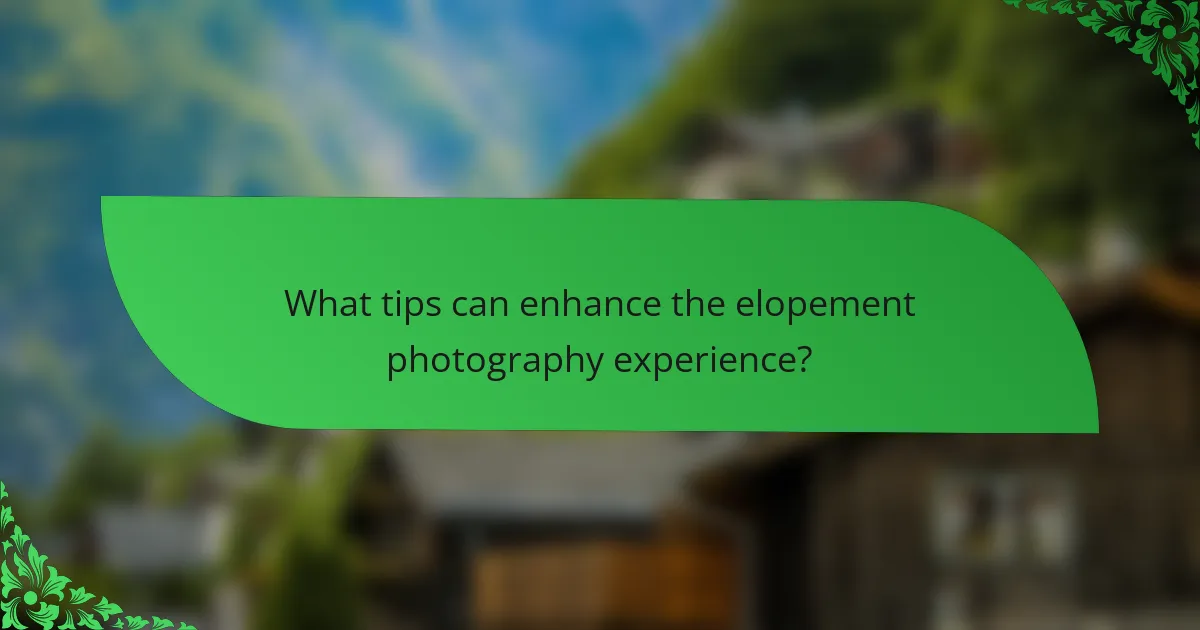
What tips can enhance the elopement photography experience?
Choose a scenic location for the elopement photography. Natural backdrops enhance the visual appeal. Consider the time of day for optimal lighting. Golden hour offers soft, flattering light for photos. Plan a timeline to capture key moments without rush. This allows for candid shots and creativity. Communicate with the photographer about desired styles. Discussing preferences ensures alignment on vision. Include personal elements in the shoot, such as meaningful objects. These details add depth to the photographs. Lastly, embrace spontaneity during the session. Authentic moments often result in the most cherished images.
How can couples prepare for their elopement photography session?
Couples can prepare for their elopement photography session by planning their location and outfits in advance. Selecting a meaningful backdrop enhances the photos. Choosing outfits that reflect their style contributes to the overall aesthetic. They should also consider the time of day for optimal lighting. Golden hour, shortly after sunrise or before sunset, provides the best natural light. Couples can create a shot list of must-have images to guide the photographer. Communicating with the photographer about their vision ensures alignment on expectations. Practicing poses can help couples feel more comfortable in front of the camera. Lastly, staying relaxed and enjoying the moment will lead to authentic, joyful photographs.
What should couples wear for their elopement photos?
Couples should wear outfits that reflect their personal style and the elopement setting. Elegant dresses or tailored suits are popular choices. Soft, flowing fabrics often photograph beautifully. Earthy tones or pastels can complement outdoor locations. Accessories like hats or floral crowns can add unique touches. Footwear should be comfortable for the terrain. Layers can be practical for changing weather conditions. Ultimately, the outfits should make the couple feel confident and authentic.
How can couples communicate their vision to the photographer?
Couples can communicate their vision to the photographer by sharing specific ideas and preferences. They should prepare a mood board or inspiration images that reflect their desired style. Discussing themes, colors, and locations helps establish a clear vision. Providing examples of poses or shots they admire can guide the photographer’s approach. Couples should also express any must-have moments they want captured. Open dialogue about expectations ensures alignment between the couple and the photographer. Regular check-ins during the planning process can refine the vision further. Clear communication fosters a collaborative relationship, enhancing the final outcome.
What common mistakes should couples avoid during elopement photography?
Couples should avoid several common mistakes during elopement photography. One major mistake is not communicating their vision with the photographer. Clear communication ensures that the photographer captures the desired style and moments. Another mistake is overlooking the importance of lighting. Poor lighting can affect the quality of photos significantly. Couples should also avoid choosing a location without considering the time of day. The right timing can enhance the ambiance of the photos.
Failing to plan for weather conditions is another mistake. Weather can change rapidly, impacting the shoot. Couples should also avoid being overly rigid with poses. Natural, candid moments often result in the best photographs. Lastly, neglecting to allocate enough time for the session can lead to rushed photos. Adequate time allows for creativity and spontaneity in capturing the day.
How can couples ensure they are relaxed during the session?
Couples can ensure they are relaxed during the session by communicating openly with each other and the photographer. Setting clear expectations helps reduce anxiety. Choosing a comfortable location can enhance relaxation. Engaging in light activities or games can create a fun atmosphere. Taking breaks during the session allows for moments of calm. Practicing deep breathing techniques can help manage stress. Familiarizing themselves with the photographer beforehand builds trust. All these strategies contribute to a more enjoyable and relaxed experience during the photography session.
What logistical issues should be planned in advance?
Logistical issues for elopement wedding photography include location permits, transportation arrangements, and timing considerations. Securing location permits is essential as many venues require prior approval for photography. Transportation arrangements must be organized to ensure timely arrival at the location. Timing considerations involve planning the shoot around optimal lighting and weather conditions. Additionally, coordinating with vendors, such as florists or officiants, is crucial for a seamless experience. Finally, having a backup plan for unforeseen circumstances, like inclement weather, is vital for successful elopement photography.
What are some best practices for capturing intimate elopement moments?
To capture intimate elopement moments effectively, focus on natural light and candid shots. Utilize soft, diffused lighting for romantic ambiance. Capture genuine emotions by anticipating moments between the couple. Use a longer lens to maintain distance while still being intimate. Frame the couple with their surroundings to enhance the storytelling. Encourage the couple to interact naturally for authentic expressions. Plan a timeline to ensure you capture key moments without rushing. Familiarize yourself with the location to find the best angles and backgrounds. These practices ensure memorable and heartfelt images that reflect the couple’s unique story.
Elopement wedding photography focuses on capturing intimate moments and personal details during private ceremonies, differing significantly from traditional wedding photography. This article outlines essential elements such as location selection, candid shot prioritization, and the importance of natural lighting. It discusses unique challenges faced by photographers, recommended equipment, and ideal camera settings for elopements. Additionally, tips for couples on planning their photography session, choosing outfits, and effective communication with photographers are provided, ensuring a successful and authentic representation of their special day.
